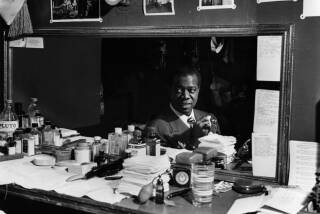George Russell dies at 86; composer influenced the evolution of jazz
- Share via
George Russell, a composer, educator and theorist who had a powerful effect on the jazz forms and methods that have evolved from the 1950s to the present, has died. He was 86.
A MacArthur Foundation Award winner, a National Endowment for the Arts Jazz Master and a Distinguished Artist-in-Residence Emeritus at the New England Conservatory, where he taught for 35 years, Russell died Monday in Boston of complications from Alzheimer’s disease.
FOR THE RECORD:
George Russell obituary: The obituary of jazz composer George Russell in Wednesday’s Section A said that among his survivors was a son, Millgardh. His son’s name is Jock Millgardh. —
Russell was a rare spokesman for the study of theoretical principles in an art form that emphasizes improvisation and spontaneity. His treatise “The Lydian Chromatic Concept of Tonal Organization” -- first published in 1953 -- had a significant effect on the growing fascination with modal and free improvisation surfacing in the late 1950s. Elements of the concept, which outlines methods by which improvisers can free themselves from the “tyranny of chords,” as Russell described it, were a factor in the modal works present in Miles Davis’ “Kind of Blue,” the bestselling album in jazz history.
Russell’s premise that jazz improvisation could reach beyond well-established harmonic foundations further validated the methods chosen by jazz artists such as John Coltrane, Eric Dolphy, Ornette Coleman, Herbie Hancock, Don Ellis, Wayne Shorter and others. His own compositions -- beginning with the startlingly inventive music on his mid-1950s breakthrough recording, “The Jazz Workshop,” continuing with his small groups of the ‘60s, occasional large ensembles of the ‘80s, and the Living Time Orchestra that he led on and off until his death -- were constantly evolving displays of the expansive possibilities of his creative overview.
“My work,” he told The Times after the MacArthur grant was awarded in 1989, “tries to achieve a kind of world view or synthesis of many kinds of musics, one that doesn’t ignore the sounds of our time. My hope is that it’s a complete music -- physical, emotional as well as thought-provoking.”
George Allen Russell was born June 23, 1923, in Cincinnati, the adopted son of Joseph, a chef on the B&O Railroad, and Bessie, a nurse. Drawn to music at an early age, he sang a number with Fats Waller at age 7 and played drums in a Boy Scout drum and bugle corps. After receiving a scholarship to Wilberforce University, he was called up for the World War II draft. But when tuberculosis was diagnosed in his examination, he was hospitalized, serendipitously with a fellow patient who instructed him in the fundamentals of music theory.
Briefly working as a jazz drummer after his release, Russell decided to explore other areas of music after hearing Max Roach play the drums, and wound up in New York City. By the mid-1940s, he had become part of an adventurous group of young musicians -- Davis, Gerry Mulligan, John Lewis, John Benson Brooks among them -- who frequented Gil Evan’s West Side apartment. Told by Davis that he wanted to “learn all the changes,” Russell interpreted the remark as a quest to find new ways to approach harmony, and he began to work on his Lydian Concept. Applying the principles he was discovering, he composed “Cubana Be/Cubana Bop” -- early examples of the blending of jazz and Afro-Cuban rhythms -- for Dizzy Gillespie’s big band.
In the 1950s, while still supporting himself with odd jobs, he wrote and recorded “The Jazz Workshop” album, which -- combined with the publication of the Lydian Concept -- thoroughly established his credibility as a jazz artist. A commission from the Brandeis Jazz Festival followed, along with the large ensemble album, “New York, New York,” which showcased Russell compositions performed by an all-star assemblage that included Coltrane, Bill Evans, Jon Hendricks and others.
Russell led his own sextets in the 1960s, but by mid-decade, the music industry’s turn toward rock music had diminished the employment potential for jazz players. He moved to Sweden until 1969, then returned to teach at the New England Conservatory.
A second volume of his Lydian Concept -- “The Art and Science of Tonal Gravity” -- was published in 2001.
He is survived by his wife, Alice; a son, Millgardh; and three grandchildren.
Heckman is a freelance writer.
More to Read
Start your day right
Sign up for Essential California for the L.A. Times biggest news, features and recommendations in your inbox six days a week.
You may occasionally receive promotional content from the Los Angeles Times.







